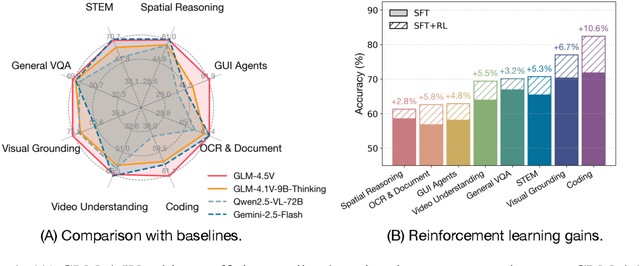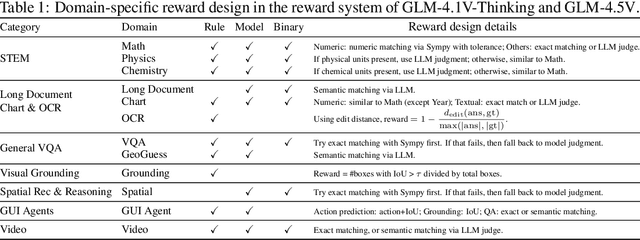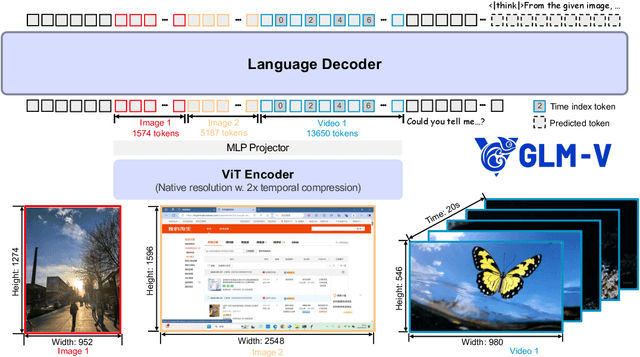Zhen Yang
School of Communication and Information Engineering, Nanjing University of Posts and Telecommunications, Nanjing 2100023, China
WebSeer: Training Deeper Search Agents through Reinforcement Learning with Self-Reflection
Oct 21, 2025Abstract:Search agents have achieved significant advancements in enabling intelligent information retrieval and decision-making within interactive environments. Although reinforcement learning has been employed to train agentic models capable of more dynamic interactive retrieval, existing methods are limited by shallow tool-use depth and the accumulation of errors over multiple iterative interactions. In this paper, we present WebSeer, a more intelligent search agent trained via reinforcement learning enhanced with a self-reflection mechanism. Specifically, we construct a large dataset annotated with reflection patterns and design a two-stage training framework that unifies cold start and reinforcement learning within the self-reflection paradigm for real-world web-based environments, which enables the model to generate longer and more reflective tool-use trajectories. Our approach substantially extends tool-use chains and improves answer accuracy. Using a single 14B model, we achieve state-of-the-art results on HotpotQA and SimpleQA, with accuracies of 72.3% and 90.0%, respectively, and demonstrate strong generalization to out-of-distribution datasets. The code is available at https://github.com/99hgz/WebSeer
Ferret-UI Lite: Lessons from Building Small On-Device GUI Agents
Sep 30, 2025Abstract:Developing autonomous agents that effectively interact with Graphic User Interfaces (GUIs) remains a challenging open problem, especially for small on-device models. In this paper, we present Ferret-UI Lite, a compact, end-to-end GUI agent that operates across diverse platforms, including mobile, web, and desktop. Utilizing techniques optimized for developing small models, we build our 3B Ferret-UI Lite agent through curating a diverse GUI data mixture from real and synthetic sources, strengthening inference-time performance through chain-of-thought reasoning and visual tool-use, and reinforcement learning with designed rewards. Ferret-UI Lite achieves competitive performance with other small-scale GUI agents. In GUI grounding, Ferret-UI Lite attains scores of $91.6\%$, $53.3\%$, and $61.2\%$ on the ScreenSpot-V2, ScreenSpot-Pro, and OSWorld-G benchmarks, respectively. For GUI navigation, Ferret-UI Lite achieves success rates of $28.0\%$ on AndroidWorld and $19.8\%$ on OSWorld. We share our methods and lessons learned from developing compact, on-device GUI agents.
GLM-4.5: Agentic, Reasoning, and Coding (ARC) Foundation Models
Aug 08, 2025Abstract:We present GLM-4.5, an open-source Mixture-of-Experts (MoE) large language model with 355B total parameters and 32B activated parameters, featuring a hybrid reasoning method that supports both thinking and direct response modes. Through multi-stage training on 23T tokens and comprehensive post-training with expert model iteration and reinforcement learning, GLM-4.5 achieves strong performance across agentic, reasoning, and coding (ARC) tasks, scoring 70.1% on TAU-Bench, 91.0% on AIME 24, and 64.2% on SWE-bench Verified. With much fewer parameters than several competitors, GLM-4.5 ranks 3rd overall among all evaluated models and 2nd on agentic benchmarks. We release both GLM-4.5 (355B parameters) and a compact version, GLM-4.5-Air (106B parameters), to advance research in reasoning and agentic AI systems. Code, models, and more information are available at https://github.com/zai-org/GLM-4.5.
Attribute Guidance With Inherent Pseudo-label For Occluded Person Re-identification
Aug 07, 2025Abstract:Person re-identification (Re-ID) aims to match person images across different camera views, with occluded Re-ID addressing scenarios where pedestrians are partially visible. While pre-trained vision-language models have shown effectiveness in Re-ID tasks, they face significant challenges in occluded scenarios by focusing on holistic image semantics while neglecting fine-grained attribute information. This limitation becomes particularly evident when dealing with partially occluded pedestrians or when distinguishing between individuals with subtle appearance differences. To address this limitation, we propose Attribute-Guide ReID (AG-ReID), a novel framework that leverages pre-trained models' inherent capabilities to extract fine-grained semantic attributes without additional data or annotations. Our framework operates through a two-stage process: first generating attribute pseudo-labels that capture subtle visual characteristics, then introducing a dual-guidance mechanism that combines holistic and fine-grained attribute information to enhance image feature extraction. Extensive experiments demonstrate that AG-ReID achieves state-of-the-art results on multiple widely-used Re-ID datasets, showing significant improvements in handling occlusions and subtle attribute differences while maintaining competitive performance on standard Re-ID scenarios.
Kimi K2: Open Agentic Intelligence
Jul 28, 2025Abstract:We introduce Kimi K2, a Mixture-of-Experts (MoE) large language model with 32 billion activated parameters and 1 trillion total parameters. We propose the MuonClip optimizer, which improves upon Muon with a novel QK-clip technique to address training instability while enjoying the advanced token efficiency of Muon. Based on MuonClip, K2 was pre-trained on 15.5 trillion tokens with zero loss spike. During post-training, K2 undergoes a multi-stage post-training process, highlighted by a large-scale agentic data synthesis pipeline and a joint reinforcement learning (RL) stage, where the model improves its capabilities through interactions with real and synthetic environments. Kimi K2 achieves state-of-the-art performance among open-source non-thinking models, with strengths in agentic capabilities. Notably, K2 obtains 66.1 on Tau2-Bench, 76.5 on ACEBench (En), 65.8 on SWE-Bench Verified, and 47.3 on SWE-Bench Multilingual -- surpassing most open and closed-sourced baselines in non-thinking settings. It also exhibits strong capabilities in coding, mathematics, and reasoning tasks, with a score of 53.7 on LiveCodeBench v6, 49.5 on AIME 2025, 75.1 on GPQA-Diamond, and 27.1 on OJBench, all without extended thinking. These results position Kimi K2 as one of the most capable open-source large language models to date, particularly in software engineering and agentic tasks. We release our base and post-trained model checkpoints to facilitate future research and applications of agentic intelligence.
GR-LLMs: Recent Advances in Generative Recommendation Based on Large Language Models
Jul 09, 2025Abstract:In the past year, Generative Recommendations (GRs) have undergone substantial advancements, especially in leveraging the powerful sequence modeling and reasoning capabilities of Large Language Models (LLMs) to enhance overall recommendation performance. LLM-based GRs are forming a new paradigm that is distinctly different from discriminative recommendations, showing strong potential to replace traditional recommendation systems heavily dependent on complex hand-crafted features. In this paper, we provide a comprehensive survey aimed at facilitating further research of LLM-based GRs. Initially, we outline the general preliminaries and application cases of LLM-based GRs. Subsequently, we introduce the main considerations when LLM-based GRs are applied in real industrial scenarios. Finally, we explore promising directions for LLM-based GRs. We hope that this survey contributes to the ongoing advancement of the GR domain.
GLM-4.1V-Thinking: Towards Versatile Multimodal Reasoning with Scalable Reinforcement Learning
Jul 02, 2025



Abstract:We present GLM-4.1V-Thinking, a vision-language model (VLM) designed to advance general-purpose multimodal understanding and reasoning. In this report, we share our key findings in the development of the reasoning-centric training framework. We first develop a capable vision foundation model with significant potential through large-scale pre-training, which arguably sets the upper bound for the final performance. We then propose Reinforcement Learning with Curriculum Sampling (RLCS) to unlock the full potential of the model, leading to comprehensive capability enhancement across a diverse range of tasks, including STEM problem solving, video understanding, content recognition, coding, grounding, GUI-based agents, and long document understanding. We open-source GLM-4.1V-9B-Thinking, which achieves state-of-the-art performance among models of comparable size. In a comprehensive evaluation across 28 public benchmarks, our model outperforms Qwen2.5-VL-7B on nearly all tasks and achieves comparable or even superior performance on 18 benchmarks relative to the significantly larger Qwen2.5-VL-72B. Notably, GLM-4.1V-9B-Thinking also demonstrates competitive or superior performance compared to closed-source models such as GPT-4o on challenging tasks including long document understanding and STEM reasoning, further underscoring its strong capabilities. Code, models and more information are released at https://github.com/THUDM/GLM-4.1V-Thinking.
Advancing Image Super-resolution Techniques in Remote Sensing: A Comprehensive Survey
May 29, 2025Abstract:Remote sensing image super-resolution (RSISR) is a crucial task in remote sensing image processing, aiming to reconstruct high-resolution (HR) images from their low-resolution (LR) counterparts. Despite the growing number of RSISR methods proposed in recent years, a systematic and comprehensive review of these methods is still lacking. This paper presents a thorough review of RSISR algorithms, covering methodologies, datasets, and evaluation metrics. We provide an in-depth analysis of RSISR methods, categorizing them into supervised, unsupervised, and quality evaluation approaches, to help researchers understand current trends and challenges. Our review also discusses the strengths, limitations, and inherent challenges of these techniques. Notably, our analysis reveals significant limitations in existing methods, particularly in preserving fine-grained textures and geometric structures under large-scale degradation. Based on these findings, we outline future research directions, highlighting the need for domain-specific architectures and robust evaluation protocols to bridge the gap between synthetic and real-world RSISR scenarios.
Hard Negative Contrastive Learning for Fine-Grained Geometric Understanding in Large Multimodal Models
May 26, 2025Abstract:Benefiting from contrastively trained visual encoders on large-scale natural scene images, Large Multimodal Models (LMMs) have achieved remarkable performance across various visual perception tasks. However, the inherent limitations of contrastive learning upon summarized descriptions fundamentally restrict the capabilities of models in meticulous reasoning, particularly in crucial scenarios of geometric problem-solving. To enhance geometric understanding, we propose a novel hard negative contrastive learning framework for the vision encoder, which combines image-based contrastive learning using generation-based hard negatives created by perturbing diagram generation code, and text-based contrastive learning using rule-based negatives derived from modified geometric descriptions and retrieval-based negatives selected based on caption similarity. We train CLIP using our strong negative learning method, namely MMCLIP (Multimodal Math CLIP), and subsequently train an LMM for geometric problem-solving. Experiments show that our trained model, MMGeoLM, significantly outperforms other open-source models on three geometric reasoning benchmarks. Even with a size of 7B, it can rival powerful closed-source models like GPT-4o. We further study the impact of different negative sample construction methods and the number of negative samples on the geometric reasoning performance of LMM, yielding fruitful conclusions. The code and dataset are available at https://github.com/THU-KEG/MMGeoLM.
HGCL: Hierarchical Graph Contrastive Learning for User-Item Recommendation
May 25, 2025Abstract:Graph Contrastive Learning (GCL), which fuses graph neural networks with contrastive learning, has evolved as a pivotal tool in user-item recommendations. While promising, existing GCL methods often lack explicit modeling of hierarchical item structures, which represent item similarities across varying resolutions. Such hierarchical item structures are ubiquitous in various items (e.g., online products and local businesses), and reflect their inherent organizational properties that serve as critical signals for enhancing recommendation accuracy. In this paper, we propose Hierarchical Graph Contrastive Learning (HGCL), a novel GCL method that incorporates hierarchical item structures for user-item recommendations. First, HGCL pre-trains a GCL module using cross-layer contrastive learning to obtain user and item representations. Second, HGCL employs a representation compression and clustering method to construct a two-hierarchy user-item bipartite graph. Ultimately, HGCL fine-tunes user and item representations by learning on the hierarchical graph, and then provides recommendations based on user-item interaction scores. Experiments on three widely adopted benchmark datasets ranging from 70K to 382K nodes confirm the superior performance of HGCL over existing baseline models, highlighting the contribution of hierarchical item structures in enhancing GCL methods for recommendation tasks.
 Add to Chrome
Add to Chrome Add to Firefox
Add to Firefox Add to Edge
Add to Edge